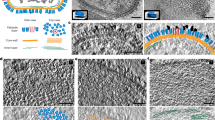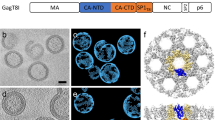Abstract
A half-century after the determination of the first three-dimensional crystal structure of a protein1, more than 40,000 structures ranging from single polypeptides to large assemblies have been reported2. The challenge for crystallographers, however, remains the growing of a diffracting crystal. Here we report the 4.5-Å resolution structure of a 22-MDa macromolecular assembly, the capsid of the infectious epsilon15 (ε15) particle, by single-particle electron cryomicroscopy. From this density map we constructed a complete backbone trace of its major capsid protein, gene product 7 (gp7). The structure reveals a similar protein architecture to that of other tailed double-stranded DNA viruses, even in the absence of detectable sequence similarity3,4. However, the connectivity of the secondary structure elements (topology) in gp7 is unique. Protruding densities are observed around the two-fold axes that cannot be accounted for by gp7. A subsequent proteomic analysis of the whole virus identifies these densities as gp10, a 12-kDa protein. Its structure, location and high binding affinity to the capsid indicate that the gp10 dimer functions as a molecular staple between neighbouring capsomeres to ensure the particle’s stability. Beyond ε15, this method potentially offers a new approach for modelling the backbone conformations of the protein subunits in other macromolecular assemblies at near-native solution states.
This is a preview of subscription content, access via your institution
Access options
Subscribe to this journal
Receive 51 print issues and online access
$199.00 per year
only $3.90 per issue
Buy this article
- Purchase on Springer Link
- Instant access to full article PDF
Prices may be subject to local taxes which are calculated during checkout




Similar content being viewed by others
References
Kendrew, J. C. et al. A three-dimensional model of the myoglobin molecule obtained by x-ray analysis. Nature 181, 662–666 (1958)
Berman, H. M. et al. The Protein Data Bank. Nucleic Acids Res. 28, 235–242 (2000)
Baker, M. L., Jiang, W., Rixon, F. J. & Chiu, W. Common ancestry of herpesviruses and tailed DNA bacteriophages. J. Virol. 79, 14967–14970 (2005)
Bamford, D. H., Grimes, J. M. & Stuart, D. I. What does structure tell us about virus evolution? Curr. Opin. Struct. Biol. 15, 655–663 (2005)
Hendrix, R. W. & Duda, R. L. Bacteriophage HK97 head assembly: a protein ballet. Adv. Virus Res. 50, 235–288 (1998)
Jiang, W. et al. Structure of epsilon15 phage reveals organization of genome and DNA packaging/injection apparatus. Nature 439, 612–616 (2006)
Prevelige, P. E. & King, J. Assembly of bacteriophage P22: a model for ds-DNA virus assembly. Prog. Med. Virol. 40, 206–221 (1993)
Wikoff, W. R. et al. Topologically linked protein rings in the bacteriophage HK97 capsid. Science 289, 2129–2133 (2000)
King, J., Haase-Pettingell, C., Robinson, A. S., Speed, M. & Mitraki, A. Thermolabile folding intermediates: inclusion body precursors and chaperonin substrates. FASEB J. 10, 57–66 (1996)
Simkovsky, R. & King, J. An elongated spine of buried core residues necessary for in vivo folding of the parallel β-helix of P22 tailspike adhesin. Proc. Natl Acad. Sci. USA 103, 3575–3580 (2006)
Breitbart, M. & Rohwer, F. Method for discovering novel DNA viruses in blood using viral particle selection and shotgun sequencing. Biotechniques 39, 729–736 (2005)
Hendrix, R. W. Bacteriophages: evolution of the majority. Theor. Popul. Biol. 61, 471–480 (2002)
Wommack, K. E. & Colwell, R. R. Virioplankton: viruses in aquatic ecosystems. Microbiol. Mol. Biol. Rev. 64, 69–114 (2000)
Bottcher, B., Wynne, S. A. & Crowther, R. A. Determination of the fold of the core protein of hepatitis B virus by electron cryomicroscopy. Nature 386, 88–91 (1997)
Conway, J. F. et al. Visualization of a 4-helix bundle in the hepatitis B virus capsid by cryo-electron microscopy. Nature 386, 91–94 (1997)
Fujiyoshi, Y. et al. Development of a superfluid helium satge for high-resolution electron microscopy. Ultramicroscopy 38, 241–251 (1991)
Chen, D. H., Jakana, J. & Chiu, W. Single-particle cryo-EM data collected on a 300-kV liquid helium-cooled electron cryomicroscope. J Chinese Electron Microscopy Soc. 26, 473–479 (2007)
Baker, M. L., Ju, T. & Chiu, W. Identification of secondary structure elements in intermediate-resolution density maps. Structure 15, 7–19 (2007)
Pan, J., Vakharia, V. N. & Tao, Y. J. The structure of a birnavirus polymerase reveals a distinct active site topology. Proc. Natl Acad. Sci. USA 104, 7385–7390 (2007)
Yuan, X. & Bystroff, C. Non-sequential structure-based alignments reveal topology-independent core packing arrangements in proteins. Bioinformatics 21, 1010–1019 (2005)
Agrawal, V. & Kishan, R. K. Functional evolution of two subtly different (similar) folds. BMC Struct. Biol. 1, 5 (2001)
Caspar, D. L. D. & Klug, A. Physical principles in the construction of regular viruses. Cold Spring Harb. Symp. Quant. Biol. 27, 1–24 (1962)
Iwasaki, K. et al. Molecular architecture of bacteriophage T4 capsid: vertex structure and bimodal binding of the stabilizing accessory protein, Soc. Virology 271, 321–333 (2000)
Yang, F. et al. Novel fold and capsid-binding properties of the lambda-phage display platform protein gpD. Nature Struct. Biol. 7, 230–237 (2000)
Nourry, C., Grant, S. G. & Borg, J. P. PDZ domain proteins: plug and play!. Sci. STKE 2003, RE7 (2003)
Tang, L., Gilcrease, E. B., Casjens, S. R. & Johnson, J. E. Highly discriminatory binding of capsid-cementing proteins in bacteriophage L. Structure 14, 837–845 (2006)
Ludtke, S. J., Baldwin, P. R. & Chiu, W. EMAN: semiautomated software for high-resolution single-particle reconstructions. J. Struct. Biol. 128, 82–97 (1999)
Harauz, G. & van Heel, M. Exact filters for general geometry three dimensional reconstruction. Optik 73, 146–156 (1986)
Goddard, T. D., Huang, C. C. & Ferrin, T. E. Visualizing density maps with UCSF Chimera. J. Struct. Biol. 157, 281–287 (2007)
Pearson, W. R. Rapid and sensitive sequence comparison with FASTP and FASTA. Methods Enzymol. 183, 63–98 (1990)
Jewett, A. I., Huang, C. C. & Ferrin, T. E. MINRMS: an efficient algorithm for determining protein structure similarity using root-mean-squared-distance. Bioinformatics 19, 625–634 (2003)
MacCoss, M. J., Wu, C. C. & Yates, J. R. Probability-based validation of protein identifications using a modified SEQUEST algorithm. Anal. Chem. 74, 5593–5599 (2002)
Kivioja, T., Ravantti, J., Verkhovsky, A., Ukkonen, E. & Bamford, D. Local average intensity-based method for identifying spherical particles in electron micrographs. J. Struct. Biol. 131, 126–134 (2000)
Saad, A. et al. Fourier amplitude decay of electron cryomicroscopic images of single particles and effects on structure determination. J. Struct. Biol. 133, 32–42 (2001)
Emsley, P. & Cowtan, K. Coot: model-building tools for molecular graphics. Acta Crystallogr. D 60, 2126–2132 (2004)
Acknowledgements
We thank D. Braun, P. Smith and B. Loftis; D. Sierkowski, P. Mikeal and S. Wilson for their support with the Condor computing system; and R. H. Goradia and M. Dougherty for digitizing the image data and preparing the Supplementary Movies respectively. This work was supported by grants from the National Institutes of Health and the National Science Foundation.
Author Contributions M.L.B. and W.J. conducted the structural analysis and contributed equally to this work. W.J. performed the image processing and reconstructions. J.J. collected the cryo-EM image data. P.R.W. performed the biochemical purification and characterization of ε15. M.L.B., W.J., P.R.W., J.K. and W.C. interpreted the results and wrote the manuscript.
Author information
Authors and Affiliations
Corresponding authors
Supplementary information
Supplementary Information
The file contains Supplementary Notes divided into two parts: Supplement 1 which discusses constructing C backbone models for gp7 and Supplement 2 discussing structural comparison between ε15 and HK97 capsid proteins, followed by additional references. The file also contains Supplementary Figures 1-8 with Legends. (PDF 28763 kb)
Supplementary Movie 1
The file contains Supplementary Movie 1 showing 4.5 Å cryo-EM map of ε15 is dissected to show the whole capsid, an asymmetric unit, and a single gp7 monomer (MOV 1887 kb)
Supplementary Movie 2
The file contains Supplementary Movie 2 showing C backbone trace of ε15 gp7 monomer. (MOV 1895 kb)
Supplementary Movie 3
The file contains Supplementary Movie 3 showing ε15 gp7 capsid model. (MOV 1845 kb)
Rights and permissions
About this article
Cite this article
Jiang, W., Baker, M., Jakana, J. et al. Backbone structure of the infectious ε15 virus capsid revealed by electron cryomicroscopy. Nature 451, 1130–1134 (2008). https://doi.org/10.1038/nature06665
Received:
Accepted:
Issue Date:
DOI: https://doi.org/10.1038/nature06665
This article is cited by
-
\({\text{COSNet}}_i\): ComplexOme-Structural Network Interpreter used to study spatial enrichment in metazoan ribosomes
BMC Bioinformatics (2021)
-
Recent advances in retroviruses via cryo-electron microscopy
Retrovirology (2018)
-
Visualizing Adsorption of Cyanophage P-SSP7 onto Marine Prochlorococcus
Scientific Reports (2017)
-
Cryo-EM reconstruction of the Cafeteria roenbergensis virus capsid suggests novel assembly pathway for giant viruses
Scientific Reports (2017)
-
Unravelling biological macromolecules with cryo-electron microscopy
Nature (2016)
Comments
By submitting a comment you agree to abide by our Terms and Community Guidelines. If you find something abusive or that does not comply with our terms or guidelines please flag it as inappropriate.



